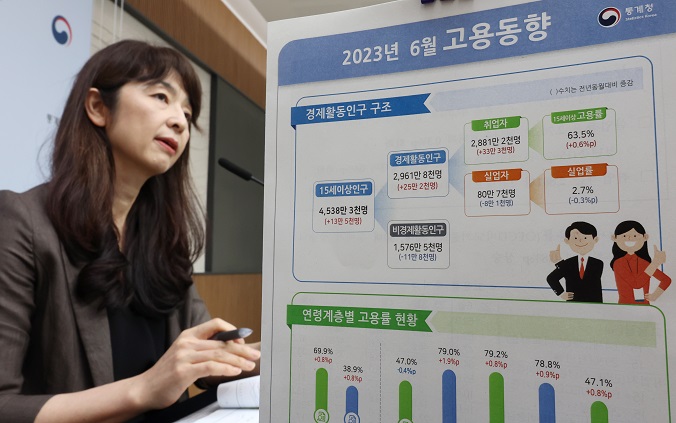
An official from Statistics Korea holds a briefing on South Korea’s monthly employment data in the central city of Sejong on July 12, 2023. (Yonhap)
SEOUL, July 12 (Korea Bizwire) — South Korea’s job additions remained stronger than expected in June on the back of the senior workforce, data showed Wednesday, although the on-year growth slowed for the third consecutive month.
The number of employed people came to 28.81 million in June, up around 333,000 from a year earlier, according to the data compiled by Statistics Korea.
South Korea’s on-year job additions slowed for nine consecutive months through February before rebounding in March, when they rose 469,000 on-year. The growth slightly slowed in April and May.
Last month, the country’s jobless rate fell 0.3 percentage point on-year to 2.7 percent.
The unemployment was the lowest since the agency compiled the data under the current criteria in 1999.
South Korea’s employment rate came to 63.5 percent, marking the highest level since the agency started compiling the data in 1982.
The job market, however, remained challenging for younger generations, as seniors took up most of the growth.
Positions for those aged 60 and above rose 343,000, with those for people in their 50s rising 71,000.
Jobs for 30-something South Koreans managed to edge up just 70,000, while those for people in their 20s decreased 103,000 over the period. The number of jobs for people in their 40s fell 34,000.
“We need to consider the impact of the falling population, considering figures for the younger generation,” an official from the agency said.
By sector, the number of jobs in the welfare and social service segment moved up 126,000, and those in the accommodation and restaurant sector advanced 116,000, as more people returned to the pre-pandemic normalcy.
Jobs in the science and technology segment also gained 98,000 over the period.
On the other hand, the number of jobs in the construction sector declined 62,000 amid economic uncertainties, and those in the transportation industry fell 39,000.
The number of jobs in the real estate sector also dropped 32,000 amid the slump in the property market.

A visitor reviews her resume at a job fair in southern Seoul, in this July 3, 2023, file photo. (Yonhap)
Meanwhile, the employment-to-population ratio of South Koreans aged 15-64 edged up 0.8 percentage point to 69.9.
In May, the Bank of Korea held the benchmark interest rate steady for the third straight time at 3.5 percent due to easing inflationary pressure amid rising concerns over an economic slowdown.
From April 2022 to January 2023, the central bank delivered seven consecutive hikes in borrowing costs. A hike in borrowing costs typically hampers employment as businesses and households cut their spending.
South Korea’s central bank plans to hold a rate-setting meeting Thursday.
Earlier this month, the finance ministry estimated the number of employed people to rise by 320,000 on-year each month in 2023, significantly up from the previous estimate of 100,000.
The revised outlook came as the number of jobs continued to increase in face-to-face services, health care and welfare, among other areas.
For the remainder of 2023, the finance ministry said in a separate report that the number of jobs in the manufacturing and construction sectors are anticipated to limit the on-year increase.
“In the second half, the employment and unemployment rates are expected to remain sound, led by the recovery of face-to-face activities and the rising demand for care-taking services,” the Ministry of Economy and Finance said.
“However, the growth is expected to narrow, due to the sluggish performance of manufacturing and construction sectors, along with the falling number of quarantine-related workforces,” it added.
The finance ministry added the robust exports of automobiles, as well as the potential resurgence of the information technology industry, are considered positive factors that could bolster ongoing job growth.
(Yonhap)






